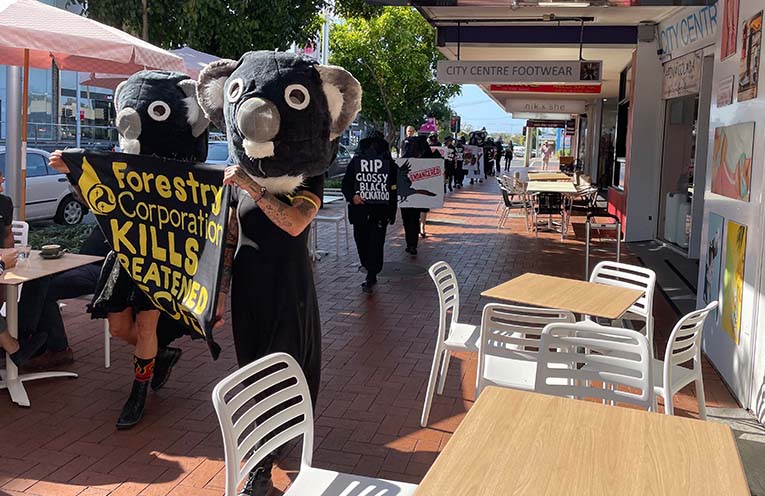
WITH Australia having one of the highest rates of native species extinction on the planet, Threatened Species Day on Thursday saw local and national activity.
Threatened Species Day is held annually on September 7, the anniversary of the death of the last Tasmanian Tiger in 1936.
 Advertise with News of The Area today.
Advertise with News of The Area today.It’s worth it for your business.
Message us.
Phone us – (02) 4981 8882.
Email us – media@newsofthearea.com.au
Recent federal State of the Environment Reports show that, during the last 200 years, more than 100 animal and plant species have become extinct and many have been reclassified from threatened to endangered.
In NSW alone there are close to 1,000 animal and plant species at risk of extinction.
Locally, the Knitting Nannas Coffs Harbour Loop swapped their knitting needles for sombre street theatre in response to logging operations along the Mid North Coast, which they say is targeting prime koala habitat.
The Nannas and friends performed a slow funeral march, cloaked in black with black veils and a token yellow armband, accompanied by a Chopin Funeral March.
Participants carried tombstones dedicated to threatened species.
“We’re raising awareness of the damage that is being done in the Great Koala National Park,” a Knitting Nannas spokesperson told News Of The Area,
“The Knitting Nanas are desperately disappointed in the performance of the NSW government who promised to gazette a national park.”
Nationally, the Federal Minister for the Environment and Water, Tanya Plibersek, released a draft strategy aimed at reducing the number of feral cats, which reportedly kill two billion native animals each year.
She also commented on the desirability of a national approach to minimising the damage to wildlife by roaming pet cats.
Elsewhere, Sustainable Population Australia (SPA), an independent not-for-profit organisation which advocates for a stabilised Australian population, released a short statement on Threatened Species Day pointing out the direct links between population growth, habitat loss and extinctions.
“Agriculture, mining, and urban sprawl have been the main causes of habitat loss and degradation,” SPA national President Jenny Goldie said.
“The more people there are, the more food, mineral resources and houses are needed.
“Our most beloved icon, the koala, was declared an endangered species by the NSW Government in 2022.
“Koalas are threatened because the eucalypt trees on which they depend are being cut down.
“Loss or fragmentation of forest leaves the koala vulnerable to predation by dogs and being struck by vehicles, and stress makes them susceptible to disease.”
Ms Goldie believes the situation is likely to get worse as the Australian population grows.
She said the Australian Bureau of Statistics reported that in 2022 Australia’s population grew by nearly half a million, or 496,800, people.
The growth rate was 1.9 percent compared to the OECD average of 0.4 percent.
“We cannot sustain such a high population growth rate and protect the habitats of other species at the same time,” Ms Goldie said.
“We already have the highest rate of mammalian extinctions in the world.
“Let’s rein in population growth and stop further extinctions.”
By Andrew VIVIAN
